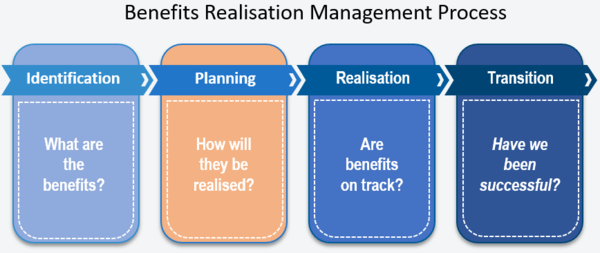4 Crucial Stages Of Benefits Realization Management
Benefits tend to be realised after projects are delivered but this does not mean that they should just be considered at that point. Benefits should not be left to chance, but identified, planned, realised and sustained throughout and beyond the life of the project. In summary, they need active and effective management. Benefits realisation management is therefore the collective set of processes, practices and techniques put in place to enable the achievement of benefits by organisations.

Four Artefacts To Improve Your Benefits Realization Management Capability:
1. Identification: What are the benefits?
At this stage, benefits are identified and assessed against the organisational strategic objectives
- Benefit Profiles: is the ‘identification card’ of the benefit; each benefit should have its own.
2. Planning: How will they be realised?
At this stage is all about ensuring that there is a robust plan for the delivery of the benefits, with defined timescales and responsibilities
- Benefits Map: shows how the benefits fit together, that is, the linkage and dependencies between them and changes and enablers required to their realisation.
- Benefits Realisation Management Plan: describes how benefits are going to be managed, that is, the strategy to be followed on all benefits realisation-related steps
- Benefits Realisation Plan: presents the plan for the realisation of benefits, including timescales, ownership, and expected targets.
- Benefits Realisation Management Process Checklist: a simple aid to ensure that all steps in the benefits realisation management process have been covered.
3. Realisation: Are benefits on track?
At this point, benefits start being measured, monitored, and reported against the targets set in the plan.
- Benefits Tracker: used to centralise the key data about a set of benefits and evaluate if the realisation is on track; can be applied at the project-level or at the portfolio-level.
4. Transition: Have we been successful?
- Benefits Realisation Management Process Checklist: a simple aid to ensure that all steps in the benefits realisation management process have been covered.
Benefits realisation management is not easy but it is not impossible either. Here are some hints and tips to get you started:
- Start with the end in mind: when you are building a jigsaw, it is helpful to know what is that end result you are after, usually displayed in the cover. The same logic applies to benefits – you need the big picture before you can focus on the details of the realisation of each benefit.
- Benefit Management is the foundation of a successful business case: a project should only get approved if is has a sound business case, inclusive of explicit benefits. This is your first chance to put benefits in everyone’s mind.
- Benefits are both financial and non-financial: people tend to focus too much on financial benefits and neglect the non-financial ones, but they are of no less importance. Think of efficiency gains, risk reduction, or satisfaction of your customers, for instance.
- Benefits demand accountability: don’t put all the benefits on the sponsor’s shoulders, accountability should be placed where the benefit is going to impact the most. Remember to also establish mechanisms for transparency and rewards.
- Intermediate outcomes are needed to realise end benefits (and are just as important): while it is important to start with the end in mind, you will also need to know how to get there: do not overlook the intermediate outcomes. These are the ones that will enable benefits to be realised.
- Benefits must be measurable: even if the measure is not straightforward, you should have a measure identified for each benefit. Remember: you cannot manage what you cannot measure.
- Benefits must be realistic: it’s normal to be optimistic about benefits but you should try to minimise that optimist bias and rely on historical data instead to estimate your project’s benefits. Also, keep the number of benefits to a sensible, manageable number.
- You need a plan: effective management means effective planning. Ensure that you have a robust Benefits Realisation Management Plan to guide you. It can save you loads of work later!




